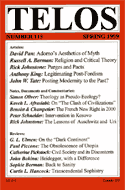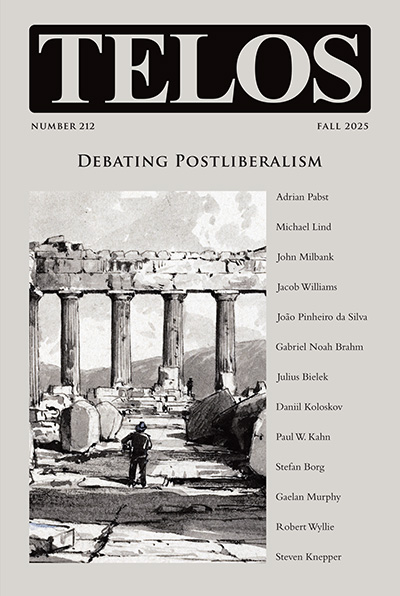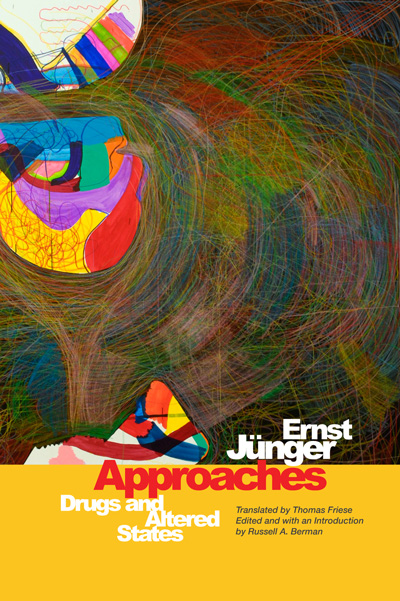Each Tuesday in the TELOSscope blog, we reach back into the archives and highlight an article whose critical insights continue to illuminate our thinking and challenge our assumptions. Today, Lev Marder looks at Russell Berman’s article “From Brecht to Schleiermacher: Religion and Critical Theory,” from Telos 115 (Spring 1999).
 Enlightenment forced the individual to turn toward the light and become “enlightened.” Two centuries after this compelling, compulsive transformation began, where has education guided, or misguided, its followers? In Russell Berman’s article “From Brecht to Schleiermacher: Religion and Critical Theory,” a tortured figure emerges. When considering the chastised innocent victim in a discussion of religion, one is conditioned to think back to the inquisition by the Church, stoning under Islamic shariah law, etc. Yet can the discussion of religion be dismissed, condemned, outlawed, or silenced on the basis of the most egregious episodes? Is this figure suffering simply because of religion or, rather, because of a certain dogmatism that is in need of critical discussion? These are some of the questions Berman examines in his article.
Enlightenment forced the individual to turn toward the light and become “enlightened.” Two centuries after this compelling, compulsive transformation began, where has education guided, or misguided, its followers? In Russell Berman’s article “From Brecht to Schleiermacher: Religion and Critical Theory,” a tortured figure emerges. When considering the chastised innocent victim in a discussion of religion, one is conditioned to think back to the inquisition by the Church, stoning under Islamic shariah law, etc. Yet can the discussion of religion be dismissed, condemned, outlawed, or silenced on the basis of the most egregious episodes? Is this figure suffering simply because of religion or, rather, because of a certain dogmatism that is in need of critical discussion? These are some of the questions Berman examines in his article.
Refraining from repeating the tired condemnation of religion, Berman instead encourages us to at least re-examine the attacks on religion. The Nazi opposition to the Church, in the not so distant past, for example, does not raise eyebrows, yet the Communist preference for Nazi objectives in this respect over the anti-fascist efforts does. Berman explains that “a pragmatic cooperation with any anti-fascists, religious or not, was undercut by a suspicion of religion on the part of the progressive camp, members of which were evidently not particularly dismayed by the fate of religion in Nazi Germany. Indeed, they were prepared to stand by and take a neutral position, privately applauding the “progressive” result of Nazi policy” (37). Torn between “religion” and Nazism, the critical thinker was abandoned to his or her own devices, allowed to be silenced, and even thrown into the gas chamber.
Berman’s range is not limited to looking at religion from Brecht’s Marxist assault on religion to Schleiermacher’s more critical defense of it. Indeed, he reaches far into the past, examining the historical horizons within which these thinkers are situated. Here, Berman brings to the surface some of deepest roots of what limits and what can possibly unbind the figure:
The key civilizational-historical issue at stake: the transition from emphatically local paganisms to axial world religions, which took place between two and three millennia ago, and, which, especially in Judaism, Christianity, Islam, and Buddhism, fundamentally transformed human ways of life and humanity’s contemplations of its own limits. To address this transition as the basis for a discussion of religion is crucial. But it is also nearly impossible in the context of the contemporary limits on discussion described above, i.e., the requirement that religion in general, and not these specific religions, be discussed. Yet, it is within these axial religions that the life of humanity is largely played out. Based on universalist revelations, i.e., experiences of the divine reported as pertaining not merely to a tribe, but to the full cosmos, these religions made enormous contributions to the process of overcoming constrictive local limitations. The world of tradition and local idol worship suddenly became obsolete, and in its place a grandly wider horizon opened up, within which more supple versions of local tradition could develop. The particular dynamism of the West derives explicitly from this conflict between local lives and universal aspirations. (43-44)
Situated between universality and the local over two millennia ago, the figure still bears the traces of the complex relation between local and universalistic drives. Even though dogmatic versions of both forms of religion seem to replace one another—pseudo-resolving the tension in favor of one or the other and leaving the figure scarred—there are signs of an alternative possibility within the tension. The tension itself is defined through the convergence of horizons, and perhaps more importantly the possibility of expanding horizons as monotheistic religion once did. How can one redirect attention back to the horizon without trying to erase it? Rather than adhere to the dogmatic forms of religion, Marxism, or the Enlightenment, Berman’s support for critical theory as a possible embracing of the tensions is intriguing. Can critical theory rescue the suffering figure? Can it offer what religion was and is supposed to offer? Is critical theory in danger of becoming “religion”?
Read the full version of Russell Berman’s article “From Brecht to Schleiermacher: Religion and Critical Theory” at the TELOS Online website. If you are affiliated with an institution that is an online subscriber to Telos, you have free access to our complete online archive. If not, you can purchase 24-hour access to this and other Telos articles at the low rate of $5/article.



